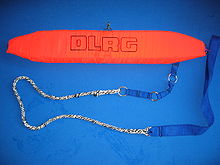
Riverboarding is a boardsport in which the participant lies prone on their board with fins on their feet for propulsion and steering. This sport is also known as hydrospeed in Europe and as riverboarding or white-water sledging in New Zealand, depending on the type of board used. Riverboarding includes commercial, recreational and the swiftwater rescue practice of using a high-flotation riverboard, designed for buoyancy in highly aerated water.
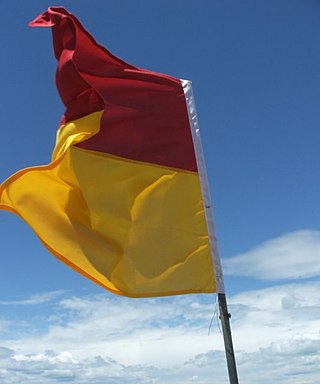
A lifeguard is a rescuer who supervises the safety and rescue of swimmers, surfers, and other water sports participants such as in a swimming pool, water park, beach, spa, river and lake. Lifeguards are trained in swimming and CPR/AED first aid, certified in water rescue using a variety of aids and equipment depending on requirements of their particular venue. In some areas, lifeguards are part of the emergency services system to incidents and in some communities, lifeguards may function as the primary EMS provider.
Human swimming typically consists of repeating a specific body motion or swimming stroke to propel the body forward. There are many kinds of strokes, each defining a different swimming style or crawl.
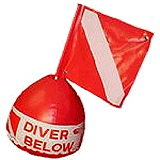
A surface marker buoy, SMB, dive float or simply a blob is a buoy used by scuba divers, at the end of a line from the diver, intended to indicate the diver's position to people at the surface while the diver is underwater. Two kinds are used; one (SMB) is towed for the whole dive, and indicates the position of the dive group throughout the dive, and the other, a delayed surface marker buoy, DSMB or decompression buoy, is deployed towards the end of the dive as a signal to the surface that the divers have started to ascend, and where they are going to surface. Both types can also function as a depth reference for controlling speed of ascent and accurately maintaining depth at decompression stops. Surface marker buoys are also used by freedivers in open water, to indicate the approximate position of the diver when submerged. They may also be used to support a catch bag or fish stringer by underwater hunters and collectors. A DSMB is considered by recreational scuba divers and service providers to be a highly important item of safety equipment, yet its use is not part of the entry level recreational diver training for all training agencies, and there are significant hazards associated with incompetent use.
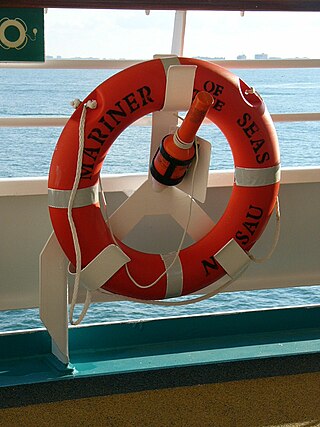
A lifebuoy is a life-saving buoy designed to be thrown to a person in water to provide buoyancy and prevent drowning. Some modern lifebuoys are fitted with one or more seawater-activated lights to aid rescue at night.
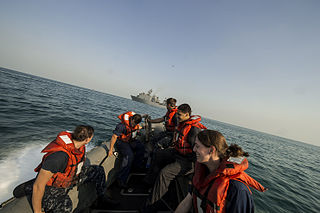
A personal flotation device is a flotation device in the form of a vest or suit that is worn by a user to prevent the wearer from drowning in a body of water. The device will keep the wearer afloat with their head and mouth above the surface – they do not have to swim or tread water in order to stay afloat and can even be unconscious.

Inflatable Rescue Boat (IRB) racing, is a surf sport in which surf lifesaving club teams race Inflatable Rescue Boats. IRB racing competitions are held in various countries, including Australia, New Zealand, South Africa, the United Kingdom, the United States, Japan, Germany, and France.

Diver rescue, following an accident, is the process of avoiding or limiting further exposure to diving hazards and bringing a diver to a place of safety. A safe place is often a place where the diver cannot drown, such as a boat or dry land, where first aid can be administered and from which professional medical treatment can be sought. In the context of surface supplied diving, the place of safety for a diver with a decompression obligation is often the diving bell.

A surfski is a type of kayak in the kayaking "family" of paddling craft. It is generally the longest of all kayaks and is a performance oriented kayak designed for speed on open water, most commonly the ocean, although it is well suited to all bodies of water and recreational paddling.

Inflatable Rescue Boats (IRBs) are rubber boats with an outboard motor used in surf lifesaving. IRBs have been used for all forms of surf rescue, retrieval, and service by Surf Lifesaving in New Zealand, Australia, and Del Mar, California since the late 1980s.

Canoe diving and Kayak diving are recreational diving where the divers paddle to a diving site in a canoe or kayak carrying all their gear in or on the boat to the place they want to dive. Canoe or kayak diving gives the diver independence from dive boat operators, while allowing dives at sites which are too far to comfortably swim, but are sufficiently sheltered.

The International Life Saving Federation (ILS) is an organisation for drowning prevention, water safety, lifesaving and lifesaving sports.

A breeches buoy is a rope-based rescue device used to extract people from wrecked vessels, or to transfer people from one place to another in situations of danger. The device resembles a round emergency personal flotation device with a leg harness attached. It is similar to a zip line. The breeches buoy may be deployed from shore to ship, ship to ship, or ship to shore using a Manby mortar, rocket, kite system, or a Lyle gun, and allows evacuation of one person at a time. A line is attached to the ship, and the person being rescued is pulled to shore in the breeches buoy.
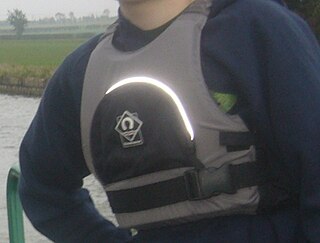
Buoyancy aids are a specialist form of personal flotation device (PFD) used most commonly by kayakers, canoeists, people practicing rafting, and dinghy sailors. They are designed as a flotation aid, rather than merely a life-saving device and have several key differences to other PFD's and lifejackets. Some buoyancy aids may not provide the same high level of protection as lifejackets.

A survival suit, more accurately and currently referred to as an immersion suit, is a type of waterproof dry suit intended to protect the wearer from hypothermia if immersed in cold water or otherwise exposed after abandoning a vessel, especially in the open ocean. Immersion suits usually have integral footwear, and a hood, and either built-in gloves or watertight wrist seals. Suits manufactured by several manufacturers also include an inflatable pillow which is permanently attached high on the back, or an inflatable tube that is attached with zippers at two points on the chest, each side of the main zipper, and circles the back. When inflated, both of these devices provide enhanced stability to the wearer, which, if conscious, allows them to keep the head above water, and to keep wind and seas from striking the face. The inflation tube is routed from the inflatable pillow over the left shoulder of the user, and secured in a loop on the chest.
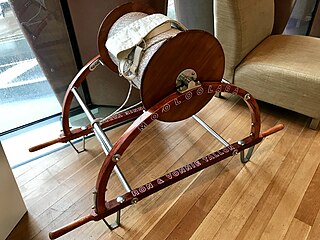
The surf life saving reel was a beach life saving apparatus from Australia.
A rescue lifeboat is a boat rescue craft which is used to attend a vessel in distress, or its survivors, to rescue crew and passengers. It can be hand pulled, sail powered or powered by an engine. Lifeboats may be rigid, inflatable or rigid-inflatable combination-hulled vessels.

Diving equipment is equipment used by underwater divers to make diving activities possible, easier, safer and/or more comfortable. This may be equipment primarily intended for this purpose, or equipment intended for other purposes which is found to be suitable for diving use.
E.M.I.L.Y. is a robotic device used by lifeguards for rescuing swimmers. Created by Hydronalix, a maritime robotic company, and funded by the United States Navy, EMILY operates on battery power and is operated by remote control after being dropped into the water from shore, a boat, pier, or helicopter. Using an impeller motor to travel through water, it is able to reach victims much faster than a human lifeguard can by swimming, and it is more compact and less expensive to maintain than crewed watercraft. It can also operate in weather and surf conditions that make other rescue attempts impractical. Once it reaches the victims its foam core allows it to function as a flotation device for four to six people holding onto side ropes or handles.
Robert "Bob" MacKenzie Burnside was an American lifeguard. He was appointed the first president of the Surf Life Saving Association of America in 1964, which later became known as the United States Lifesaving Association. In 1965, he was appointed president of the National Surf Life Saving Association. In 1967, he developed the revolutionary plastic “Burnside Rescue Can”, now a standard for lifeguards worldwide and iconic symbol of beach lifeguarding. He was a champion swimmer who introduced the Malibu balsa surfboard to Australia. He wrote the History of Junior Lifeguarding.
